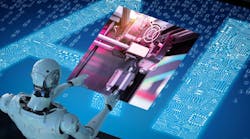Data, AI and the Generative Design Revolution
Engineering is a combination of creativity, critical thinking and mathematics. Historically, innovation in engineering design has been constrained primarily by the human capacity to perform the calculations required to bring imaginative solutions to life. With the dawning of generative design, engineers will be able to tap into computational power in ways never previously possible, ushering in a new era of innovation.
Engineers have relied on digital assistants for decades, starting with CAD software in the 1980s. CAD applications can draw designs more accurately and efficiently than the humans employing them, shortening the time required to execute designs and thus allowing engineers to consider more design possibilities.
Incorporating artificial intelligence (AI), generative design goes far beyond its CAD predecessors. The most basic form of generative design is topology optimization. This process algorithmically analyzes a user’s design and identifies areas where mass can be removed without compromising the design’s integrity. The resulting designs appear organic and alien, as if created by nature. Yet they serve their purpose better than those designs created solely by a human—performing better while using significantly less mass. A person hoping to arrive at a similar solution would be forced to spend days performing the impossibly complex calculations that a computer can execute in minutes.
While topology optimization excels at refining existing designs, it still requires the engineer to provide an initial design, understand what forces will act on their design and enter these parameters into the computer. The more advanced forms of generative design tap into cloud computing and the exponential increases in processing power it provides. This allows an engineer to explore dozens of potential solutions in parallel and test them in virtual simulations featuring thousands of force vectors.
As a result, engineers can optimize their designs for variables beyond mass, including fluid dynamics, thermal properties and fabrication methods. At the same time, AI has progressed to the point where entire systems can be overhauled, going beyond the piecemeal improvements to individual components afforded by topology optimization. With the addition of 3D printing, it’s now feasible to manufacture the sinuous shapes created with generative design.
These developments will shift the role of the engineer to curating parameters and test conditions, and then choosing the best design from a range of permutations generated by AI. Eventually even the design-selection process will require AI assistance, as the sheer range of generated solutions outpaces the engineer’s ability to sort through them.
Liberated from the tedious trial and error of refining their designs, engineers can focus on what their design needs to accomplish rather than how the design will be realized. The more the design process is automated, the less innovation depends on the skill of the engineer. With full generative design, even inexperienced engineers will be able to bring their ideas to life without spending years mastering physics, manufacturing techniques or structural analysis. Product differentiation also becomes more achievable, as designers bring to market unique, AI-generated designs that humans couldn’t even imagine, let alone execute.
The possibilities for innovation expand further when generative design is combined with other technologies of the fourth industrial revolution. For example, IoT sensors can provide a wealth of real-world performance data from active mechanical parts. This data in turn can be fed to the product’s digital twin, adjusting the design to account for real-world conditions. At this stage, engineers no longer need to define the physics parameters that impact their design—sensors will provide this information in real-time.
With further increases in computational power, generative design be able to simulate the entire lifecycle of a product and extend its peak performance. The more real-world IoT data augments the simulation, the more true-to-life the simulation becomes. The traditional process of designing, testing and iterating falls by the wayside, replaced by generative design’s self-improving feedback loop.
Further out on the horizon, quantum computing will have a momentous effect as a near-infinite range of possibilities is generated in seconds, presenting engineers with the best possible design to fit their parameters. Add in natural language processing and it’s conceivable that new designs could be spun up merely from a user’s verbal description of their engineering problem, then “manufactured” on the spot through 3D printing.
As fantastic as this future may seem, the question is not if it will ever arrive, but when.
Jesse Coors-Blankenship is senior vice president of Technology for PTC.
